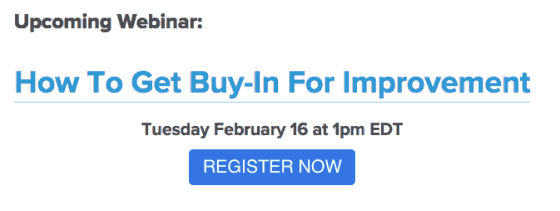Another question I get thrown at me very often is something along the lines of “How do we get more buy in for ______” with that space being filled with Lean, Kaizen, 5S, using the EMR system, improvement, or any number of terms.
If you do a Google search for
Lean “lack of buy in”
There are many results.
What do you read?
“I [our friend Jamie Flinchbaugh] am frequently engaged to overcome a lack of buy-in at organizations…”
“A lack of buy-in is most common in organizations that are new to Six Sigma.”
Ah, so it's not just a Lean problem. I'm sure people used to ask “How do we get more buy in for TQM?” back in the day or “How do we get more buy in for these Deming ideas?”
“Even with Senior Management's buy-in, lack of buy-in from from operational management …”
People are often blaming the employees for their lack of buy in, but the problem is seen when looking in any direction.
“The lack of buy-in, resistance, and push back starts the second we begin…”
“…this leads to a lack of buy-in from those most needed in the process…”
“…uncertainly, and anxiety, often leading to lack of buy-in and employee resistance.”
That last quote, from Peter Hines and co-authors, is starting to get beyond blame.
WHY is there a lack of buy in?
“Why?” is a really powerful Lean question, and we could try to do a “5 Whys” analysis here (or a “Many Whys” analysis).
The lack of buy in often traces back to a:
- Lack of engagement
- Not being involved in defining the problem, just being given a solution
- Lack of communication
- Lack of trust (people fear layoffs, maybe for good reason)
- Lack of leadership
We might hear a complaint of, “There's a lack of buy in about 5S” when the problem is that 5S is being pushed on people and maybe it's being used to solve trivial “problems” instead of real problems that matter.
Rather than getting well into some Lean initiative and discovering “there's a lack of buy in because our Lean efforts have only focused on cost,” the time to get “buy in” or engagement is EARLY in a project, initiative, or transformation.
That's a lesson that we demonstrate and learn through the Experience Change simulation that's part of the workshop I'm now facilitating (including in the Dallas area on March 15).
In the simulation, which I ran a few weeks ago in San Antonio, participants work together in small teams to understand a case study that's built around the need to improve patient flow through the emergency department. The simulation is about “implementing Lean” but it's really about working to solve a problem that matters.
That's one reason the simulation doesn't give participants a good score if they jump to action too quickly, trying to push solutions on people without first building a case for change… without communicating effectively.
One group in that last workshop was really frustrated… being very experienced with Lean, they saw the need to jump to action. The problem needs solving now! “Enough with the presentations,” said one guy in a group.
As I blogged about before, John Kotter wrote about how under communication is often a fatal flaw in big change initiatives. To communicate effective to a large organization, you're going to have to feel like you're OVER communicating. You need to use lots of different channels and media to reach people and to get your message across. Oh, and the communication had better be two-way communication.
In the workshop simulation, as in real life, if you get too far down a path of action without getting proper buy in… there's no going back. It's too late. Game over.
It's better to learn these lessons in a safe environment, like a computer simulation, and a workshop. If you'd like to learn more about the workshop, see this webinar that I did late last year, and click here to contact me if you'd like to talk about bringing this learning experience to your organization.
What have you seen in your organizations and experience? What leads to a “lack of buy in?” Is there anything other than time, effort, communication, and leadership that gets more people “on board” with change? Are we blaming those who aren't “buying” or thinking about those who maybe aren't doing the right “selling?”
Reminder: Greg Jacobson, MD and I are also doing a free webinar on February 16 on this topic of “buy in.” Click here to register.
Please scroll down (or click) to post a comment. Connect with me on LinkedIn.
Let’s work together to build a culture of continuous improvement and psychological safety. If you're a leader looking to create lasting change—not just projects—I help organizations:
- Engage people at all levels in sustainable improvement
- Shift from fear of mistakes to learning from them
- Apply Lean thinking in practical, people-centered ways
Interested in coaching or a keynote talk? Let’s start a conversation.











Chapter 1 of Taiichi Ohno’s book, Toyota Production System, is titled: “Starting From Need.” In other words, TPS was created from actual business needs: low productivity and slow growth (transition from sellers’ to buyers’ markets for automobiles). Others recognized the need when they felt hardship (i.e. the Oil Crisis in 1973).
If people do not see or feel the need for change, then buy-in is difficult to obtain. It is true that the top leader is responsible for helping people recognize the need (and how they will benefit), yet it is also true that leaders ignore business needs which is often clearly seen by people at lower levels but not by leaders.
If a business serves a competitive buyers’ market, then the need for TPS is high and remains constant — productivity improvement is always needed, and slow economic growth is with us more often than not.
Ohno concludes Chapter 1 by saying “We [leaders] must understand these situations in-depth before we can achieve a revolution in consciousness.” That means leaders must: 1) recognize reality and 2) overcome entrenched ways of thinking as a prerequisite to seeking buy-in. This is why leadership matters; it determines what happens or does not happen.
Thanks for the comment, Bob.
When I get asked (and I get asked this often), “What Lean tool should I start with?” I steer things back to the Ohno question.
Ohno also wrote about focusing on the “most pressing needs.”
Organizing pens in the nurses station is not as pressing of a need as improving patient safety is.
What is the flip side of buy-in? Resistance to change.
Lack of buy-in (resistance) at the top may be irremediable. If leadership isn’t on board the train isn’t leaving the station. A change initiative in this environment is nothing but lip service.
When we are facilitating change closer to the front line, however, there are specific steps for dealing with resistance. Among them:
– Assure that the reasons for change are clearly articulated and interpreted for the audience at hand.
– Listen to, reflect back, record, and honor the concerns of the people involved.
– Address these concerns as a part of the change management exercise.
– Challenge the people who raised the concerns: what are the obstacles? what is your next step?
Addressing the concerns of associates is not just about “overcoming resistance”, it is about success! The people doing the work know where things can go wrong and are doing us a favor, supporting successful change by identifying obstacles when they raise a red flag.
In my experience “buy-in” has never been in issue in such an environment.
(with grateful bows to Shigeo Shingo and Mike Rother)
-ALB
Well said, Andrew.
To the question of senior leaders, they are accountable to their boards. Where is the leadership from the hospital / health system boards. The board can take the same approach that you described there with executives… but the board needs to send a message to executives that mediocrity won’t be accepted, nor will excuses — we all need to work together on improvement.